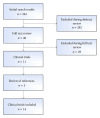Towards a low-cost mobile subcutaneous vein detection solution using near-infrared spectroscopy
- PMID: 24883388
- PMCID: PMC4032719
- DOI: 10.1155/2014/365902
Towards a low-cost mobile subcutaneous vein detection solution using near-infrared spectroscopy
Abstract
Excessive venipunctures are both time- and resource-consuming events, which cause anxiety, pain, and distress in patients, or can lead to severe harmful injuries. We propose a low-cost mobile health solution for subcutaneous vein detection using near-infrared spectroscopy, along with an assessment of the current state of the art in this field. The first objective of this study was to get a deeper overview of the research topic, through the initial team discussions and a detailed literature review (using both academic and grey literature). The second objective, that is, identifying the commercial systems employing near-infrared spectroscopy, was conducted using the PubMed database. The goal of the third objective was to identify and evaluate (using the IEEE Xplore database) the research efforts in the field of low-cost near-infrared imaging in general, as a basis for the conceptual model of the upcoming prototype. Although the reviewed commercial devices have demonstrated usefulness and value for peripheral veins visualization, other evaluated clinical outcomes are less conclusive. Previous studies regarding low-cost near-infrared systems demonstrated the general feasibility of developing cost-effective vein detection systems; however, their limitations are restricting their applicability to clinical practice. Finally, based on the current findings, we outline the future research direction.
Figures




Similar articles
-
Vein Pattern Locating Technology for Cannulation: A Review of the Low-Cost Vein Finder Prototypes Utilizing near Infrared (NIR) Light to Improve Peripheral Subcutaneous Vein Selection for Phlebotomy.Sensors (Basel). 2019 Aug 16;19(16):3573. doi: 10.3390/s19163573. Sensors (Basel). 2019. PMID: 31426370 Free PMC article. Review.
-
Need help finding a vein?Nursing. 2007 Jun;37(6):39-41. doi: 10.1097/01.NURSE.0000271810.56917.a0. Nursing. 2007. PMID: 17538434 No abstract available.
-
An innovative approach to near-infrared spectroscopy using a standard mobile device and its clinical application in the real-time visualization of peripheral veins.BMC Med Inform Decis Mak. 2014 Nov 25;14:100. doi: 10.1186/s12911-014-0100-z. BMC Med Inform Decis Mak. 2014. PMID: 25421099 Free PMC article.
-
Making the invisible visible: near-infrared spectroscopy and phlebotomy in children.Telemed J E Health. 2010 Oct;16(8):889-93. doi: 10.1089/tmj.2010.0061. Epub 2010 Oct 6. Telemed J E Health. 2010. PMID: 20925568
-
New biomedical devices that use near-infrared technology to assist with phlebotomy and vascular access.Pediatr Emerg Care. 2013 Mar;29(3):383-5; quiz 386-7. doi: 10.1097/PEC.0b013e31828680f9. Pediatr Emerg Care. 2013. PMID: 23462399 Review.
Cited by
-
A Novel Method of Vein Detection with the Use of Digital Image Correlation.Entropy (Basel). 2021 Mar 28;23(4):401. doi: 10.3390/e23040401. Entropy (Basel). 2021. PMID: 33800598 Free PMC article.
-
Enhancing Parathyroid Gland Visualization Using a Near Infrared Fluorescence-Based Overlay Imaging System.J Am Coll Surg. 2019 May;228(5):730-743. doi: 10.1016/j.jamcollsurg.2019.01.017. Epub 2019 Feb 13. J Am Coll Surg. 2019. PMID: 30769112 Free PMC article.
-
Necrosis of the thumb after inadvertent injection of diclofenac in the radial artery: a case report.J Pain Res. 2017 Dec 13;10:2803-2806. doi: 10.2147/JPR.S150306. eCollection 2017. J Pain Res. 2017. PMID: 29263695 Free PMC article.
-
Vein Pattern Locating Technology for Cannulation: A Review of the Low-Cost Vein Finder Prototypes Utilizing near Infrared (NIR) Light to Improve Peripheral Subcutaneous Vein Selection for Phlebotomy.Sensors (Basel). 2019 Aug 16;19(16):3573. doi: 10.3390/s19163573. Sensors (Basel). 2019. PMID: 31426370 Free PMC article. Review.
-
The System Design and Evaluation of a 7-DOF Image-Guided Venipuncture Robot.IEEE Trans Robot. 2015 Aug;31(4):1044-1053. doi: 10.1109/TRO.2015.2452776. IEEE Trans Robot. 2015. PMID: 26257588 Free PMC article.
References
-
- Strehle E-M. Making the invisible visible: near-infrared spectroscopy and phlebotomy in children. Telemedicine Journal and e-health. 2010;16(8):889–893. - PubMed
-
- Zharov VP, Ferguson S, Eidt JF, Howard PC, Fink LM, Waner M. Infrared imaging of subcutaneous veins. Lasers in Surgery and Medicine. 2004;34(1):56–61. - PubMed
-
- de Graaff JC, Cuper NJ, Mungra RA, Vlaardinherbroek K, Numan SC, Kalkman CJ. Near infrared light to aid peripheral intravenous cannulation in children: a cluster randomized clinical trial of three devices. Anaesthesia. 2013;68(8):835–845. - PubMed
-
- Mansoor M, Sravani SN, Naqvi SZ. Real-time low-cost infrared vein imaging system. Proceedings of the International Conference of Signal Processing, Image Processing & Pattern Recognition (ICSIPR '13); 2013; pp. 117–121.
-
- Crisan S, Tarnovan IG, Crişan TE. A low cost vein detection system using near infrared radiation. Proceedings of the IEEE Sensors Applications Symposium (SAS '07); February 2007; San Diego, Calif, USA.
Publication types
MeSH terms
LinkOut - more resources
Full Text Sources
Other Literature Sources

